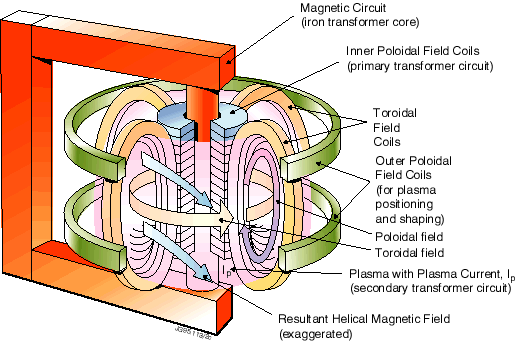Submitted by Dallas Kachan on

Some latest scuttlebutt from the world of nuclear fusion has all the ingredients of a Hollywood thriller screenplay (and for those who remember the Cleantech Avenger, you know I know scuttlebutt!)
There’ve been all kinds of cinematic ideas, and personalities, on the front lines of the crazy world of cleantech innovation. Wild claims from charismatic mad scientists abound.
So hearing word that a tiny company has potentially cracked the code of fusion energy and created a working megawatt-scale reactor that actually produces more power than it requires is something I'd normally dismiss as yet another tale from the lunatic fringe.
But, in this case, I trust the source. So, whether you believe nuclear energy is cleantech or not—and especially if you don’t—read on.
In researching a new Kachan report on new safer, cleaner nuclear technology, we interviewed dozens of scientists at nuclear research outfits like Flibe Energy, General Atomics, General Fusion, Helion Energy, Hyperion Power Generation, the International Thermonuclear Experimental Reactor (ITER), Invap, Lightbridge, NuScale, Ottawa Valley Research, QPower, Radix Power and Energy Corp, Rare Earth Extraction Co., Rhodia, Scandinavian Advanced Technology (SCATEC), Terra Power, Thor Energy, Thorium One International, Tri Alpha Energy and U.S. National Ignition Facility (NIF).
Most fusion organizations are pursuing big, capital-intensive tokamaks and other reactors. But one interviewee, in a face-to-face conversation in an exotic location abroad, told us of a small company he’s involved with that he claims has built a working 1MW fusion reactor the size of a rice cooker (though it's dubious that approximation includes the requisite shielding, cooling, turbines, etc.) The company is now apparently in the process of building a 10MW version that it plans to trial in 2012.
If true, it would turn a lot of heads, in particular at organizations like the international €15 billion ($20.4 billion) ITER project, the multi-billion dollar U.S. National Ignition Facility, and smaller fusion companies like General Fusion, Helion Energy and Tri Alpha Energy. And maybe, just maybe, represent a new energy production paradigm.

A generic tokamak-based design for a fusion reactor. NOT the design employed by our secretive fusion company. ITER's tokamak is 98 feet tall and is taking years to build. Administrators expect ITER to require somewhere between €30 billion ($41 billion) and €50 billion ($68 billion) to hit its goals by 2040. Illustration source: Splung.com.
More on the company in a moment. First, a quick primer on fusion:
Why fusion matters
Nuclear fusion has represented a Holy Grail of power potential since the 1950s. Fusion reactors, in theory, mimic the internal processes of the sun and other stars by fusing atoms. Typically, this means combining a plasma of hydrogen atoms into helium. This is in contrast to today’s fission reactors, which typically split solid uranium atoms. The fusion process would emit heat that would ultimately drive electricity generators and could serve many other purposes, such as keeping buildings warm and firing up high-temperature industrial operations.
The potential advantages of fusion are enormous. Compared to conventional fission, a fusion reactor theoretically ticks several very important boxes in today’s safety-conscious nuclear energy world. Here's an excerpt from the fusion benefits section of our report on nuclear innovations:
- It cannot melt down, so the potential for a radioactive leak is miniscule. Fusion tends to run on very little fuel, and the fuel stops fusing as soon as conditions become imperfect. Thus, a loss of power to the reactor would shut down the reaction, with no threat of runaway, uncontrollable events. While this would carry financial consequences, it does not pose the safety risk associated with conventional fission reactors, in which large volumes of fuel can carry on fissioning in an outage. In fission, if cooling and/or control mechanisms fail, meltdown can ensue, as happened at Fukushima.
- It produces relatively little radioactivity. The levels are extremely low and very short-lived compared to the long-lived, highly toxic radioactive waste of conventional fission reactors.
- Its waste poses little weapons proliferation risk. The waste that fusion produces cannot be used to make bombs, although some believe that the tritium that it breeds does pose a proliferation risk.
- There are potential uses for fusion’s helium waste. Helium is widely used in the medical industry for, among other things, cooling the superconducting magnets in MRI scanners, and in welding.
- Most components of a potential fusion fuel are plentiful. Most fusion projects aim to use deuterium and tritium. Deuterium is plentiful—it’s the stuff that Canadian CANDU “heavy water” reactors use as moderators in fission reactions. It occurs commonly in water. It’s so common in seawater that, according to fusion company Helion Energy, the potential energy in 1 barrel of seawater equals that of 700 barrels of oil. The other hydrogen isotope, tritium, does not occur naturally. Fusion fuel makers will have to obtain their first doses from either CANDU reactors, where it is a byproduct, or from other sources, like the weapons community. But the good news is that once fusion starts, it breeds its own new tritium.
- It requires very little fuel. Most proposed fusion reactors rely on very small amounts of deuterium and tritium. ITER, the massive international fusion project in France, plans to deploy a mere 2 grams of deuterium and tritium at any one time in its 98-foot-tall reactor. By comparison, utilities typically load fission reactors with hundreds of rods of uranium at a time.
- Fuel costs are low. If a year’s worth of coal carries a value of “1”, then the combined cost of the deuterium and tritium would be 0.0005. The uranium in fission would cost 0.1, significantly more than fusion fuel.
- It does not emit CO2 or other greenhouse gases. While this is also true for fission reactions, it adds to the appeal of fusion as a baseload clean energy source.
If fusion sounds too good to be true, that’s because, so far, it has been. As of this writing, there’s been no independent verification that anyone has yet successfully built a working fusion reactor that can produce sustained energy greater than that put into it.
Enter our small fusion company. Our source, concerned he was telling us too much, initially wouldn’t even reveal its name.
The fission wonder down under?
As mentioned, this company and its story seem to have all the elements of a Hollywood thriller:
- Harnessing the power of nature! The analogy most often applied to fusion is harnessing the reaction of the sun. But this company’s fusion reaction, fueled by deuterium and tritium, isn’t nearly as high temperature, our source claims, and is more “rooted in nature.” Specifically, the reaction is said not to require the high temperature, high pressure or accelerated particles of others’ approaches. “The key is not how many neutron hits you generate, but how you sustain them, how well you can control them.” For a 40-watt power input, the reactor is said to be able to generate a megawatt.
- Exotic locales! The company is based in Australia. Why? “Everyone’s expecting big nuclear innovations to come out of China, or France,” said our source. But it’s replicated its intellectual property and technology “around the world in case they get infiltrated.”
- Self-funded by mad scientist! The technology’s inventor has apparently tinkered with his design for 40 years, and self-funded the company’s early stages, reinvesting income from earlier lucrative inventions. Now, strategic investors are said to include family money, such as a Shanghai real estate baron and decedents of American industrialist John Pitcairn, Jr.
- Culture of secrecy! The company’s secrecy about its actual progress makes Apple look sophomoric. In development since the 90s, it has sworn employees and investors not to let on how successful its research has been. It’s said to have retained the former head of Israel’s counter terrorism unit as its chief of security.
- No to takeover offers! The company is said to have already fielded a buyout attempt by General Electric (NYSE:GE). The founder apparently didn’t want the invention owned by just one corporation, characterizing it an invention for mankind, apparently.
- Requisite military involvement! The company is said to be secretly working with the Australian Air Force and Navy, and the U.S. Department of Defense, and aims to trial a 10MW version of its reactor in 2012 with an Australian utility.
- Political and industrial upheaval! If fusion can be made to work at scale, it could indeed affect the world in profound ways. All the ingredients for drama!
More about this secretive company, and other companies working to radically improve nuclear power as we know it today, is available in Kachan’s new Emerging Nuclear Innovations report, just released. This 64-page report rounds up 6 months of looking carefully at the nuclear power industry for companies best placed to usurp big, conventional fission of the type that powers the 432 non-military nuclear reactors that exist worldwide today.
Beyond fusion, the report also looks at improvements in conventional light water reactors (LWRs), including boiling water reactors (BWRs) and pressurized water reactors (PWRs), use of thorium as a fuel in molten salt and solid fuel reactors, molten salt reactors (MSRs), fast neutron reactors (FNRs), pebble bed reactors (PBRs) and modular reactors.
So don’t write off the nuclear power industry after Fukushima. Despite last March’s meltdown in Japan, the World Nuclear Association believes that in the 33 countries that currently operate nuclear reactors, capacity will increase 52-200%, to between 559 and 1,087 gigawatts in 2030 (up from 367 gigawatts today). Among countries that don’t already use nuclear power, those with plans to do so could add another 30-123 gigawatts, and new potential entrants could increase that by yet another 13-140 gigawatts.
Expect that new, safer nuclear technologies—possibly even fusion—will be part of that growth.
A former managing director of the Cleantech Group, Dallas Kachan is now managing partner of Kachan & Co., a cleantech research and advisory firm that does business worldwide from San Francisco, Toronto and Vancouver. Kachan & Co. staff have been covering, publishing about and helping propel clean technology since 2006. Kachan & Co. offers cleantech research reports, consulting and other services that help accelerate its clients’ success in clean technology. Details at www.kachan.com.

Comments
The fusion reactor Hollywood SHOULD love
Permalink Submitted by driver49 (not verified) on Thu, 11/24/2011 - 08:52.
....considering it came from the same mind that invented television.
http://fusor.net
Fusion power
Permalink Submitted by Lisa (not verified) on Thu, 11/24/2011 - 13:58.
Fusion electrical power plants may be the only way planet Earth will survive unscathed.
Lisa
Your comments about that "down under" nuclear fusion company
Permalink Submitted by Anonymous (not verified) on Thu, 12/01/2011 - 05:13.
I am an investor in the company you mentioned, but not close enough to the action to evaluate the credibility of their technology. In my quest to know more about whether my investment will ever pan out, I was wondering whether you could offer anything more on who your source was and how credible they might be. I realize that you may not be willing to provide any more detail, but it never hurts to give it a try. Thanks in advance.
Source must stay unnamed
Permalink Submitted by Dallas Kachan on Thu, 12/01/2011 - 09:57.
Sorry, we're sworn to secrecy!